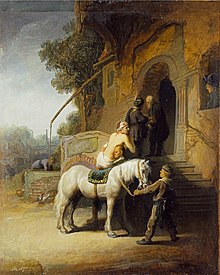User:This lousy T-shirt/Parable of the Good Samaritan

The parable of the Good Samaritan is a parable of Jesus written in the New Testament in Luke 10:25-37. Robbers attack a Jewish traveler and leave him lying wounded along the road. A priest and a Levite pretend to ignore the man as they walk by but a Samaritan stops to help him even though Samaritans and Jews were considered "enemies."[1]
What Jesus said[change | change source]
In the Gospel of Luke, the parable is introduced by a question:
Behold, a certain lawyer stood up and tested him, saying, "Teacher, what shall I do to inherit eternal life?"
He said to him, "What is written in the law? How do you read it?"
He answered, "You shall love the Lord your God with all your heart, with all your soul, with all your strength, and with all your mind [Deuteronomy 6:5]; and your neighbour as yourself [Leviticus 19:18]."
He said to him, "You have answered correctly. Do this, and you will live."
But he, desiring to justify himself, asked Jesus, "Who is my neighbour?"
— Luke 10:25–29, World English Bible
Jesus replies with a story:
Jesus answered, "A certain man was going down from Jerusalem to Jericho, and he fell among robbers, who both stripped him and beat him, and departed, leaving him half dead. By chance a certain priest was going down that way. When he saw him, he passed by on the other side. In the same way a Levite also, when he came to the place, and saw him, passed by on the other side. But a certain Samaritan, as he traveled, came where he was. When he saw him, he was moved with compassion, came to him, and bound up his wounds, pouring on oil and wine. He set him on his own animal, and brought him to an inn, and took care of him. On the next day, when he departed, he took out two denarii, and gave them to the host, and said to him, 'Take care of him. Whatever you spend beyond that, I will repay you when I return.' Now which of these three do you think seemed to be a neighbour to him who fell among the robbers?"
He said, "He who showed mercy on him."
Then Jesus said to him, "Go and do likewise."
— Luke 10:30–37, World English Bible
What it means[change | change source]


Samaritans and Jews were enemies at the time this parable was told. Tensions between them were higher than ever because Samaritans had desecrated the Jewish Temple at Passover.[2] The road from Jerusalem to Jericho was called the "Way of Blood" because "of the blood which is often shed there by robbers."[3] This is reminiscent of Jesus teaching his disciples to love their enemies. An enemy treated the fallen traveler more compassion than he got from one of "his own kind."
The message for modern listeners is: "Treat him well. He is your brother. You might need his help one day."[4][5][6][7][8]

As a metaphor and name[change | change source]
The term "good Samaritan" is used as a common metaphor: "The word now applies to any charitable person, especially one who, like the man in the parable, rescues or helps out a needy stranger."[9]
The name has consequently been used for a number of charitable organisations, including Samaritans, Samaritan's Purse, Sisters of the Good Samaritan, and The Samaritan Befrienders Hong Kong. The name Good Samaritan Hospital is used for a number of hospitals around the world. Good Samaritan laws encourage those who choose to serve and tend to others who are injured or ill.[10]

Other pages[change | change source]
- Ethic of reciprocity
- Karma
- Samaritanism
- Theology of relational care
- Expounding of the Law
- Christian-Jewish reconciliation
- Bystander effect
References[change | change source]
- ↑ Funk, Robert W., Roy W. Hoover, and the Jesus Seminar. The five gospels. HarperSanFrancisco. 1993. "Luke" p. 271-400
- ↑ Vermes, Geza. The authentic gospel of Jesus. London, Penguin Books. 2004. p. 152-154.
- ↑ Wilkinson, "The Way from Jerusalem to Jericho" The Biblical Archaeologist, Vol. 38, No. 1 (Mar., 1975), pp. 10-24
- ↑ Karl Barth's theological exegesis by Richard E. Burnett 2004 ISBN 0802809995 pages 213-215
- ↑ Prejudice and the People of God: How Revelation and Redemption Lead to Reconciliation by A. Charles Ware 2001 ISBN 0825439469 page 16
- ↑ William Jay, Miscellaneous Writings on Slavery, John P. Jewett & Company, 1853.
- ↑ Sundee Tucker Frazier, Check all that apply: finding wholeness as a multiracial person, InterVarsity Press, 2002, ISBN 083082247X, p. 6.
- ↑ Klyne Snodgrass, Stories with Intent: A comprehensive guide to the parables of Jesus, Eerdmans, 2008, ISBN 0802842410, p. 361.
- ↑ Dictionary of Classical, Biblical, & Literary Allusions
- ↑ Mark Lunney and Ken Oliphant, Tort Law: Text and Materials, 3rd ed., Oxford University Press, 2008, ISBN 0199211361, p. 465.
- ↑ Roland E. Fleischer and Susan C. Scott, Rembrandt, Rubens, and the Art of their Time: Recent perspectives, Pennsylvania State University Press, 1997, ISBN 0915773104, pp. 68-69.
Other websites[change | change source]
- Biblical Art on the WWW:
Good Samaritan, Parable of the
Category:Samaritan culture and history
Category:Bible
Category:Christianity
Category:Jesus Christ
